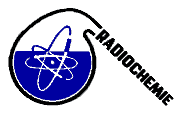Speaker
Dr
Galina Lujaniene
(Institute of Physics, Savanorių ave 231, Vilnius, LT-02300, Lithuania)
Description
Natural clay and iron minerals of complex composition are reactive mineral phases which can affect retardation and transport of radionuclides in the environment. Therefore, it is important to understand and quantify sorption of radionuclides on them. Sorption of Cs, Pu(IV), Pu(V) and Am(III) at trace concentrations on three well characterized samples of Triassic clay as a function of pH and composition of solution and contact time was studied. Sorption experiments were also performed with three iron oxide minerals found in the clay mineral coatings and microorganisms (bacteria and fungi) isolated from the clay and groundwater samples with the aim of better understanding the effects of various natural clay components on the speciation and sorption behavior of radionuclides. The character of bonding of Cs, Pu and Am to the clay samples was analyzed by sequential extraction (SE). Solvent extraction techniques (using TTA, HDEHP, DBM and PMBP), ultrafiltration and alpha spectrometry as well as ICP-MS were employed to characterize the oxidation states of the plutonium species in liquid and solid phases.
The results have indicated that iron oxide coatings play an important role in binding of Pu(IV) on the clay, whereas ion exchange and CaCO3 were found to be responsible for the binding of Am(III). The coatings also affected Cs sorption from solutions of variable ionic strength. Sorption experiments with microorganisms indicated that bacteria and fungi can exert different effect on the sorption behavior of Pu. Kinetic data evaluated by kinetic models derived for six different control processes mostly indicated a sorption mechanism controlled by Pu or Am diffusion in the inert layer on the surface of clay. Corresponding kinetic coefficients were determined. Surface complexation modeling of the sorption dependence on pH using a two-site surface complexation model showed high affinity of all the minerals for Pu(OH)3+ at pH > 4. Iron oxide minerals also sorbed Pu(OH)40: goethite at pH>8, hematite at pH=7-9 and magnetite at pH > 5.5. Am3+ and Am(NO3)2+ were found to be the most selectively sorbed species on all the minerals from NaNO3 solutions in the pH range of 3.5-5, whereas AmOH2+ and Am(OH)2+ were sorbed to a different extent on different minerals at pH 5-9.
The stability constants obtained by modeling have indicated that the sorption affinity of the clay for Pu is higher than that of the iron oxides studied, while the sorption affinities for Am are mutually comparable. In addition, it has been found that Pu is much more selectively (i.e. strongly) bound than Am on all the minerals studied. This well corresponds with the higher exchangeability of Am found by SE and can explain its higher mobility in the environment.
The research was supported by the Ministry of Education and Science of the Republic of Lithuania and the Lithuanian State Science and Studies Foundation projects V-19/2009, NKS-B SPECIATION project (2008-2009), FP7 RECOSY, grant No 212287.
Primary author
Dr
Galina Lujaniene
(Institute of Physics, Savanorių ave 231, Vilnius, LT-02300, Lithuania)
Co-authors
Dr
Dušan Vopalka
(Czech Technical University in Prague, Department of Nuclear Chemistry, Prague 1, Brehova 7, Czech Republic)
Ms
Eglė Radžiūtė
(Institute of Physics, Savanorių ave 231, Vilnius, LT-02300, Lithuania)
Ms
Justina Šapolaitė
(Institute of Physics, Savanorių ave 231, Vilnius, LT-02300, Lithuania)
Dr
Karel Štamberg
(Czech Technical University in Prague, Department of Nuclear Chemistry, Prague 1, Brehova 7, Czech Republic)
Dr
Loreta Levinskaitė
(Institute of Botany, Žaliųjų ežerų 49, Lt-2021, Vilnius Lithuania)
Prof.
Petr Beneš
(Czech Technical University in Prague, Department of Nuclear Chemistry, Prague 1, Brehova 7, Czech Republic)
Dr
Vytautas Aninkevičius
(Semiconductor Physics Institute, A. Goštauto 11, Vilnius LT-01108, Lithuania)

